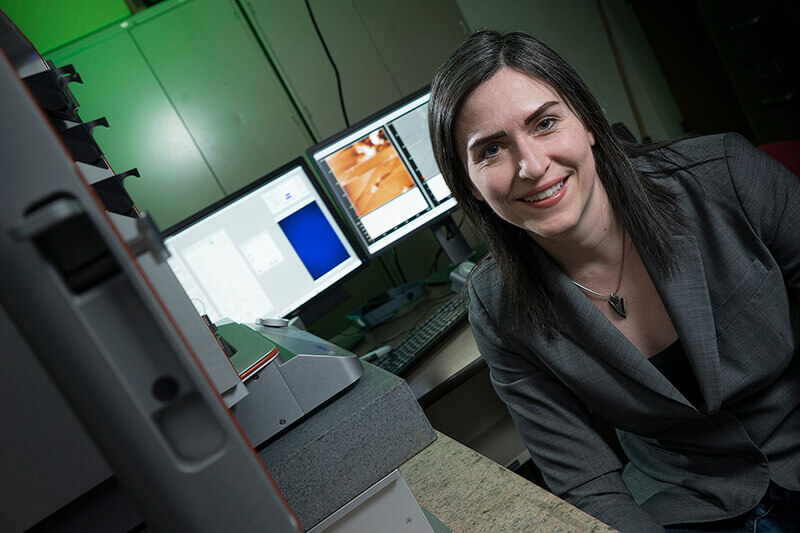January 23, 2019
Animal, plant biology aids in improving electronic and energy conversion devices, Purdue discovers
Tech wizards to tech novices may benefit from the ability to “grow” solar cells and advance electronics, computers and energy conversion devices.
WEST LAFAYETTE, Ind. – Inspired by the unique structural elements of animal and plant biological cell membranes, Purdue University researchers have scaled up the production of nanoscale electronics by replicating the living molecular precision and “growing” a circuit of solar cells for use on electronic surfaces.
The technology could address some of the greatest challenges in the production of nanoscale electronic and optoelectronic devices: scaling up to meet production demand of better, faster phones, computers and other electronic devices.
 Shelley Claridge, an assistant professor at Purdue University, is leading research to improve electronic and energy conversion devices. (Image by Vincent Walter)
Download image
Shelley Claridge, an assistant professor at Purdue University, is leading research to improve electronic and energy conversion devices. (Image by Vincent Walter)
Download image
In cellular membranes, molecules with distinctive heads and tails stand together, tightly packed, like commuters in a subway at rush hour. For the most part, only the heads of the molecules are exposed to the environment around the cell, where they control interactions with other cells and with the world at large.
“Biology has developed a phenomenal set of building blocks for embedding chemical information in a surface,” said Shelley Claridge, an assistant professor of chemistry and biomedical engineering at Purdue, who leads the group. “We hope to translate what we have learned from biological design to address current scaling challenges in industrial fabrication of nanoscale electronic and optoelectronic devices.”
One of those scaling challenges relates to controlling surface structure at scales below 10 nanometers — a need common to modern devices for computing and energy conversion.
Claridge’s research group has found that it is possible to design surfaces in which phospholipids sit, rather than stand on the surface, exposing both heads and tails of each molecule. Because the cell membrane is remarkably thin, just a few atoms across, this creates striped chemical patterns with scales between 5 and 10 nm, a scale very relevant to device design.
One unique discovery by the team reveals that these striped, ‘sitting’ monolayers of phospholipids influence the shape and alignment of liquid nanodroplets placed on the surfaces. Such directional wetting at the molecular scale can localize solution-phase interactions with 2D materials, potentially facilitating deposition of constituents for graphene-based devices.
The Purdue Office of Technology Commercialization has filed multiple patents on the technology. OTC are looking for partners for continued research and to take the technology to market.
The work aligns with Purdue's Giant Leaps celebration, celebrating the global advancements in sustainability as part of Purdue’s 150th anniversary. This is one of the four themes of the yearlong celebration’s Ideas Festival, designed to showcase Purdue as an intellectual center solving real-world issues.
About Purdue Office of Technology Commercialization
The Purdue Office of Technology Commercialization operates one of the most comprehensive technology transfer programs among leading research universities in the U.S. Services provided by this office support the economic development initiatives of Purdue University and benefit the university's academic activities. The office is managed by the Purdue Research Foundation, which received the 2016 Innovation and Economic Prosperity Universities Award for Innovation from the Association of Public and Land-grant Universities. For more information about funding and investment opportunities in startups based on a Purdue innovation, contact the Purdue Foundry at foundry@prf.org. For more information on licensing a Purdue innovation, contact the Office of Technology Commercialization at otcip@prf.org. The Purdue Research Foundation is a private, nonprofit foundation created to advance the mission of Purdue University.
Writer: Chris Adam, 765-588-3341, cladam@prf.org
Source: Shelley Claridge, claridge@purdue.edu
